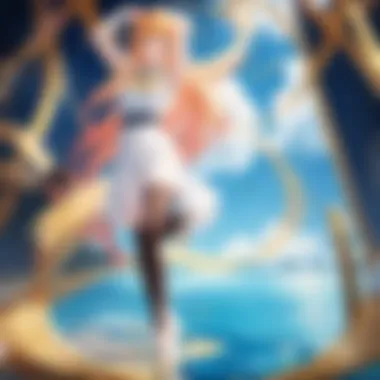Exploring the Concept of 'Golden Time' in Anime


Intro to the Series
The concept of 'Golden Time' in anime relates closely to critical moments that define character arcs and narrative choices. This thematic exploration fits well within the genre of drama and romance, where emotions run high and decisions often have significant consequences. Series like Golden Time, which aired in 2013, exemplify this phenomenon by presenting pivotal events that resonate with viewers.
Golden Time, based on the light novel by Yuyuko Tokemiya, has a unique narrative that combines romance with elements of college life and self-discovery. It revolves around Banri Tada, a law student who suffers from amnesia. His quest to redefine himself and his relationships adds layers to the concept of 'Golden Time', as viewers witness moments that catalyze intense personal growth. The series captures the essence of time, not only in a literal sense but also in emotional and relational contexts, showcasing how fleeting moments can shape one's destiny.
This series gained popularity for its intricate storytelling and well-developed characters. Audience reception was largely positive, highlighting its ability to evoke a range of emotions, from joy to sorrow. The blend of humor and heartfelt moments allowed it to stand out from other titles in the romance genre. Critics praised its realistic portrayals of relationships, making it relatable to many young adults navigating similar experiences.
In the following sections, we will analyze the importance of 'Golden Time' within Golden Time and other notable anime series, unpacking how these moments resonate across various genres. By examining character arcs and narrative techniques, we aim to provide insights into the impact of these critical moments on viewers and creators alike.
Defining Golden Time
The exploration of the concept of Golden Time in anime is essential for understanding how temporal dynamics contribute to storytelling and character growth. Golden Time encompasses those crucial moments that define narratives, creating emotional peaks and deepening audience engagement. Without an understanding of this concept, one might overlook the ways stories resonate on various levels. This section outlines the importance of defining Golden Time within anime.
Historical Context
Historically, the association of time with storytelling can be traced back to ancient forms of narrative. In literature and oral histories, pivotal moments often drove the plot forward. In anime, as the medium evolved, the awareness of these moments became formalized, particularly during the late twentieth century.
When we analyze early anime, we see that themes involving time appeared sporadically. For instance, series like Astro Boy showcased foundational elements of character development, while exploring deeper themes like mortality and growth. Many early works did not fully utilize time as a narrative mechanism but laid the groundwork for future explorations. The arrival of more complex series during the 2000s meant creators began to take further advantage of Golden Time concepts. Shows like The Girl Who Leapt Through Time exemplify how time manipulation can frame emotional relationships and character evolution.
This historical context highlights how today’s anime often utilizes established tropes around time. Understanding this development can enhance appreciation for contemporary narratives and enrich views on their thematic complexity.
Contemporary Interpretations
In today's anime landscape, Golden Time is interpreted through various lenses, significantly motivated by cultural shifts and audience expectations. Modern series often embrace complex narratives that explore nonlinear storytelling, self-reflection, and the consequences of choices over time. This has reshaped how viewers perceive time within narratives.
For example, series such as Steins;Gate have cultivated a fanbase by treating time not merely as a backdrop but as a central character in its own right. This shows the influence of technology, both in narrative techniques and thematic depth. Fans engage with the intricate plots that challenge their perception of reality, time, and causality.
Additionally, anime like My Dress-Up Darling employ these concepts to create deeply relatable characters who exist within nuanced timelines. Viewers get a strong sense of nostalgia intertwined with life lessons that emerge through careful character arcs. Such shows highlight how contemporary interpretations of Golden Time not only engage with time as a mechanical element but offer significant emotional depth that resonates with audiences.
"Time is an illusion. It is a concept that governs our lives, yet in storytelling, it becomes a tool for exploration and introspection."
In summary, recognizing both the historical and contemporary interpretations of Golden Time allows for a deeper appreciation of anime's narrative craftsmanship, providing fans and critics alike with a framework for analyzing character growth and thematic richness.
The Role of Time in Anime Narratives
The notion of time plays an essential role in shaping anime narratives. Time is not merely a backdrop for the actions and events; it is a dynamic element that influences character choices, plot progression, and thematic depth. Understanding time as a pivotal narrative device can reveal layers of meaning within a story, thereby enhancing the enjoyment and engagement for viewers. By analyzing how time is utilized in anime, we can better appreciate its complexities and the nuances that creators wish to convey.
Time as a Narrative Device
In many anime, time is manipulated to serve as a crucial narrative device. This manipulation can manifest in various forms, including flashbacks, time skips, or even time loops. Each of these methods allows creators to present information in a non-linear fashion, thereby enabling viewers to piece together the story gradually. For example, in Steins;Gate, the use of time travel introduces a sense of urgency and raises questions about causality, significantly affecting the audience's perception of character motivations and outcomes.
By employing time in such ways, anime not only entertains but prompts viewers to reflect on the consequences of actions taken at different moments. Thus, time can enhance dramatic tension or create emotional resonance.
Temporal Distortions in Storytelling


Temporal distortions, such as time dilation or alternate timelines, also serve an important function in storytelling. These distortions can alter how viewers understand time itself within the anime universe. In Your Name, for instance, the story revolves around two characters who experience life in different timelines, creating a unique narrative experience that engages viewers on multiple levels.
Such distortions challenge traditional conceptions of linear time. They encourage audiences to think critically about fate, chance, and the choices that shape their lives. Viewers are left with questions about the nature of time, often contemplating its relative nature and what it means to connect with others across different temporal planes.
The manipulation of time adds complexity to narratives, inviting viewers into a deeper exploration of themes such as memory, change, and identity. Ultimately, this role of time in anime narratives is not just about keeping the story moving; it also enriches the experience by providing us insights into the characters and the worlds they inhabit.
Character Development Through Time
In anime, character development is crucial for both engagement and storytelling depth. The progression of characters is often rooted in the passage of time, which shapes their journeys, challenges, and transformations. Time serves not just as a backdrop, but as an active element that influences decisions and growth. This interplay between time and character evolution provides viewers with a more profound understanding of the characters’ motivations and arcs.
Character Arcs and Growth
Character arcs are central to understanding an individual's journey within any narrative. In anime, time often acts as a catalyst for growth, propelling characters into situations that challenge their beliefs or morals. Through various events—trials faced, relationships built, and losses experienced—characters often realize their potential or confront their fears.
Through experiences across episodes or seasons, the audience witnesses how characters evolve. For instance, in the series Attack on Titan, Eren Yeager's transformation from a naive youth to a conflicted leader embodies a powerful character arc driven by the relentless passage of time and the weight of his experiences. This gradual evolution keeps viewers invested, as they watch the character confront personal demons and navigate the complexity of their world.
The Influence of Time on Relationships
Time impacts not only individual growth but also the dynamics of relationships within anime narratives. Relationships are often forged or broken against the canvas of time, influencing character decisions and emotional states.
Consider the bond between Shinji Ikari and Rei Ayanami in Neon Genesis Evangelion. Their relationship is heavily influenced by the experiences they share over time. As the narrative unfolds, viewers see how past events and personal struggles shape their interactions. Internal conflicts, vulnerabilities, and the desire for connection highlight how essential time is in realizing relationship dynamics.
The depth of character relationships thrives when time permits change and adaptation. Encounters can lead to misunderstandings or reconciliations, ultimately showcasing the fluidity of human connections.
"In the realm of anime, time is not merely a measurement but a defining thread that weaves together the lives of characters. It creates intricate tapestries of love, loss, and growth that resonate with viewers."
In summary, character development through time is a complex yet rewarding aspect of anime narrative. It not only enriches character arcs and relationships but also enhances viewer engagement, providing insights into the struggles and triumphs inherent in the human experience.
Golden Time in Popular Anime Series
The phenomenon of 'Golden Time' is a crucial aspect of storytelling within anime, influencing both narrative structure and character dynamics. In this section, we explore how specific series harness the concept of time to engage audiences and drive character development. By examining Golden Time in these popular contexts, we can better understand its thematic significance and the viewer's emotional investment.
Analysis of Time-Related Themes
In numerous anime, the concept of time serves as a thread linking various arcs and episodes. Themes surrounding time often manifest through the experiences characters face in their journey, adding depth to both the plot and their relationships.
For example, one common theme is the fluidity of time, where characters might experience moments that stretch or compress their perception of reality. This can symbolize essential life lessons, such as the fleeting nature of youth or the permanence of decisions made in pivotal moments.
Another prevalent theme is the cyclical nature of time, where events or situations recur, forcing characters to confront their pasts. This approach can instill a sense of continuity, showing how past actions influence present circumstances. Through these themes, anime creators not only craft engaging stories but also pose philosophical questions about existence, growth, and the nature of time itself.
"Time is a relentless river, carrying us toward moments that define who we are."
Notable Examples from Specific Series
Several anime series exemplify the concept of Golden Time, weaving intricate narratives around time-related themes. Some notable examples include:


- Steins;Gate: This series explores time travel and its consequences, engaging the viewer with moral dilemmas that arise from altering past events. The protagonist's struggles create a sense of urgency and highlight the emotional stakes involved in each decision.
- Your Name: Here, time acts as a bridge connecting two characters from different eras. This narrative device deepens the love story while exploring the themes of connection and destiny, as characters experience each other's lives across time.
- Re:Zero – Starting Life in Another World: The protagonist's ability to return to a specific point in time complicates his experiences. Each return provides a different perspective on the events unfolding, illustrating how choices and timing can drastically alter outcomes.
- The Girl Who Leapt Through Time: This film addresses the beauty and burden of time manipulation. The protagonist discovers the impact of seemingly trivial actions, bringing attention to how the choices we make can ripple through time.
In these examples, Golden Time is not just an abstract concept but a tangible element that shapes narratives and enhances character depth. These series demonstrate that the manipulation of time can lead to engaging storytelling, drawing viewers into a world where every moment counts.
Viewer Engagement with Golden Time
Understanding viewer engagement with the concept of 'Golden Time' is central to grasping how anime narratives capture and retain audience attention. The engagement hinges on the ability of pivotal moments to evoke strong emotional reactions, which are crucial for maintaining interest. Fans often find meanings and connections to these moments, enhancing their viewing experience. Such engagement fosters a sense of belonging and community among viewers, as they share and discuss these transformative experiences.
Emotional Resonance and Investment
Emotional resonance is a key factor in how audiences connect with anime. When a character faces a significant challenge or a moment of clarity, viewers likely feel those emotions along with the character. This shared experience cultivates a deep-seated investment in characters and plots.
For example, in the series Your Lie in April, the golden moments where Kōsei plays the piano resonate with viewers on multiple levels.
- Connection to Personal Experiences: Many viewers relate to themes of loss or redemption, making such instances powerful.
- Relevance of Timing: The careful placement of these pivotal moments heightens their impact, ensuring they do not arrive too early or too late in the narrative.
In many ways, these moments act as catalysts for character development and plot progression. When viewers experience these moments, they often reflect on their own lives, leading to a stronger bond with the narrative.
"The success of anime in engagement often relies on its ability to fuse emotional narrative with powerful thematic moments."
Audience Perception of Time in Stories
The perception of time within anime storytelling plays a significant role in shaping how viewers engage with the plot. Audiences are often attuned to the flow of time and its manipulation. Different anime utilize time in various ways, including flashbacks, time loops, or even non-linear storytelling. Each method influences audience perception as it alters the context in which events unfold.
- Pacing: The pacing of events affects viewer anticipation. For instance, in Steins;Gate, the non-linear exploration of time draws viewers in, as they try to piece together the timeline alongside the character.
- Suspension of Disbelief: When time bends or breaks within a story, it invites viewers to suspend disbelief and engage more deeply with the narrative.
The complexity of time in anime challenges viewers to reconsider the way they perceive stories. As viewers witness time being manipulated, they realize that the concept of 'Golden Time' is not just a thematic element, but also a narrative strategy that enhances their overall experience. This insight can lead to greater appreciation for storytelling techniques unique to anime.
Thematic Elements Connected to Golden Time
Golden time in anime extends beyond a mere timeframe. It encapsulates themes and narrative devices that enrich stories and resonate deeply with viewers. Understanding these elements is crucial for appreciating how anime employs time to forge connections between characters and audiences.
Philosophical Implications of Time
The philosophical dimensions of time in anime often reveal complex ideas. Central to many narratives, the concept of time raises essential questions about existence, choice, and consequence. For instance, the exploration of alternate timelines can depict the consequences of different decisions made by characters. This not only challenges viewers to think critically about their own choices but also invites them to ponder deeper existential themes.
Moreover, time can represent the impermanence of moments. Characters experience growth and transformation, emphasizing that change is inevitable. This correlation reinforces a philosophical viewpoint that embraces both individuality and interconnectedness. In series like Steins;Gate, the protagonist grapples with the effects of time travel, revealing the heavy burden of altering past events and the philosophical weight it carries. Such narratives demonstrate that the manipulation of time can lead to significant moral dilemmas.
"Anime often uses time not just as a setting but as a crucial component of its philosophical narrative, challenging viewers to consider the choices they make."
Cultural Reflections on Time
Anime serves as a reflection of cultural attitudes towards time. In cultures where the past significantly influences the present, such as Japan, the portrayal of time often underscores the importance of history and memory. This cultural perspective can be seen in series like Your Name, where the connection between characters stretches across different timeframes and realities. This illustrates how the past can carry profound implications for future relationships.
Additionally, the representation of time in anime can vary significantly across genres. For example, in slice-of-life anime, time flows slowly, emphasizing mundane moments that contribute to character growth. In contrast, shounen action series may employ rapid pacing, using time to heighten tension and excitement. This variation resonates with viewers differently, as genre conventions influence their perception of time.


In many ways, the thematic exploration of time fosters a broader understanding of cultural narratives. By examining how anime embodies different time-related themes, one can gain insight into the cultural contexts that shape storytelling. Engaging with these elements not only enriches viewer experience but also cultivates a deeper appreciation for the artistry involved in crafting narratives around time.
The Future of Time in Anime Storytelling
The exploration of time in anime storytelling continues to evolve, reflecting trends in viewer expectations and technological innovations. The future of this concept, especially regarding 'Golden Time,' holds significant implications for character development, narrative structure, and audience engagement. Understanding these elements is crucial for both creators and fans. As anime grows in popularity worldwide, there is a greater demand for stories that resonate deeply and challenge traditional narratives. This section examines emerging trends and technological advancements that shape how time is perceived and utilized in anime.
Emerging Trends in Anime Narratives
Current anime narratives are increasingly embracing unconventional approaches to time. Here are some noticeable trends:
- Non-linear Narration: Many series are experimenting with non-linear storytelling, where events are presented out of chronological order. This structure keeps audiences engaged by creating suspense and intrigue. Examples include series like Steins;Gate and Re:Zero - Starting Life in Another World, where time loops and alternate timelines redefine the narrative.
- Exploration of Multi-Dimensions: Anime like Fate/Zero uses parallel universes to explore different outcomes based on characters' choices across timelines. This theme often leads to profound character development, allowing viewers to witness diverse aspects of a character’s personality across different scenarios.
- Deeper Psychological Themes: As the genre grows, creators are delving into the psychological implications of time. Stories may explore themes of regret, nostalgia, or lost opportunities. This reflective engagement enhances the emotional weight of the narrative, connecting viewers on a more personal level.
These trends signify a shift in storytelling that not only entertains but also encourages critical thinking about time and its significance in human experience.
Technological Advances and Their Impact
Technology fundamentally alters the landscape of anime production and storytelling. Some notable impacts include:
- High-Quality Animation Techniques: With advancements in animation software, studios can create scenes that visually represent complex time concepts more effectively. This allows for more intricate action sequences and smoother transitions between different time periods, enhancing the viewer's experience.
- Virtual Reality and Interactive Storytelling: The emergence of VR technology opens new avenues for anime. Imagine engaging with a story where viewers can manipulate time and choices in real-time. This immersive experience could redefine how narratives are conveyed, blending traditional storytelling with interactive gameplay.
- Global Distribution and Streaming Services: Platforms like Netflix and Crunchyroll provide access to diverse anime series, allowing creators from different cultures to share their interpretations of time. This cross-pollination leads to innovative narratives that blend varying traditions and philosophies about time.
"As anime continues to adopt new technologies and narrative frameworks, the possibilities for 'Golden Time' are virtually limitless. It invites makers to push boundaries further than ever before."
The future of time in anime storytelling showcases a landscape rich with variety and opportunity for deeper connection, encouraging both audiences and creators to engage meaningfully with the narratives they encounter. As we look ahead, it is clear that the intersection of technology and storytelling techniques will significantly influence the evolution of anime.
Epilogue: The Significance of Golden Time
The analysis of 'Golden Time' in anime reveals a nuanced understanding of how key moments shape narratives and character development. This concept is integral to many anime series, impacting both storytelling and viewer engagement. Recognizing these moments enhances appreciation of the medium and deepens the connection between viewers and content.
The importance of 'Golden Time' can be summarized across several key elements:
- Narrative Structure: Pivotal moments create turning points in the story, driving the plot forward and leading to resolutions that resonate with audiences.
- Character Depth: These moments illustrate character growth, showcasing how individuals evolve in response to time and circumstances.
- Viewer Connection: Engaging scenes evoke emotional reactions, making audiences feel invested in the journey of the characters.
The exploration of the 'Golden Time' concept provides insights that are essential for both creators and fans alike. It encourages a more profound analysis of anime narratives.
Recapitulation of Key Insights
Throughout the article, multiple dimensions of 'Golden Time' have been examined. From its historical context to contemporary interpretations, several points stand out:
- Historical Development: The term has roots in storytelling traditions, evolving in modern anime to signify more than just time.
- Impact on Anime: Significant moments serve to elevate plots in various genres, from action-packed shonen to introspective slice-of-life narratives.
- Cultural Reflections: Cultural views on time inform how stories are told, exploring themes of memory, nostalgia, and anticipation.
By analyzing these aspects, the significance of 'Golden Time' grows clearer, illustrating its role in enhancing narrative engagement.
Final Thoughts on its Role in Anime
In closing, 'Golden Time' contributes significantly to the richness of anime. It exemplifies how intricate storytelling can engage viewers on personal levels. As anime continues to evolve, understanding and utilizing the concept of golden time may shape future narratives.
The appreciation of these nuanced moments enhances the viewing experience. Ultimately, recognizing 'Golden Time' offers anime enthusiasts a greater perspective on the stories they love.
"Time in storytelling is not just a measure but an experience that connects us to the characters' journeys."
In summary, 'Golden Time' serves as a valuable lens through which we can enhance our understanding of anime's narrative landscape.















